CAPP
The Carpinteria Advanced Purification Project (CAPP) will replenish the groundwater basin with purified recycled water, creating a locally-controlled, drought-resistant drinking water supply.
Funding Efforts to Date
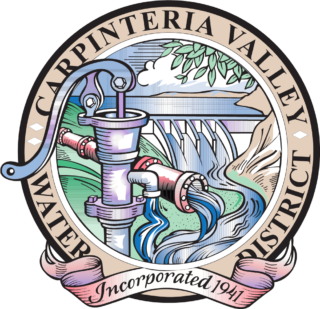
- The District has been pursuing grant funding and low-interest financing for CAPP since the project was initially developed in 2016. In 2022 and 2023, the District was awarded $26 million in grant funding from state and federal sources, including State Water Resources Control Board ($8.0 million), United States Bureau of Reclamation ($17 million), and California Department of Water Resources ($1.1 million for two different grants). The District intends to pursue additional state and federal grant funds. .
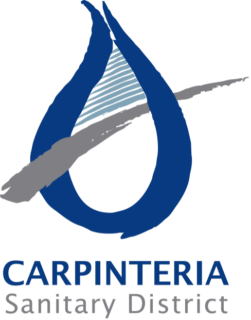
- Additionally, the District submitted a low-interest State Revolving Fund (SRF) loan application to the State in 2019 and was added to the eligible projects list in 2020. In early 2024, the District entered into a loan agreement with the state.
- Funding for the project is in place and bids from contractors are expected in June of 2025.
Water Supply Update
Over the past few decades, the District and our customers have seen just how unpredictable our surface water supplies are during times of drought, with our State Water Project and Lake Cachuma allocations becoming extremely variable and unreliable. When faced with limited surface water, we have become highly dependent on pumping groundwater from the Carpinteria Groundwater Basin to deliver water to your tap. However, groundwater takes years to recharge and requires steady and consistent winter rain which is never guaranteed.
Over the past few decades, the Carpinteria Valley Water District (CVWD) and our customers have seen just how unpredictable our surface water supplies are during times of continuing and historic drought, due to our State Water Project and Lake Cachuma allocations becoming extremely variable and unreliable. When faced with limited surface water, we have become highly dependent on pumping groundwater from the Carpinteria Groundwater Basin to deliver water to your tap. However, groundwater takes years to recharge and requires steady and consistent winter rain which is never guaranteed. CAPP will create a solution that provides us with a locally managed and controlled water supply every day, including during times of prolonged drought and water supply shortages.
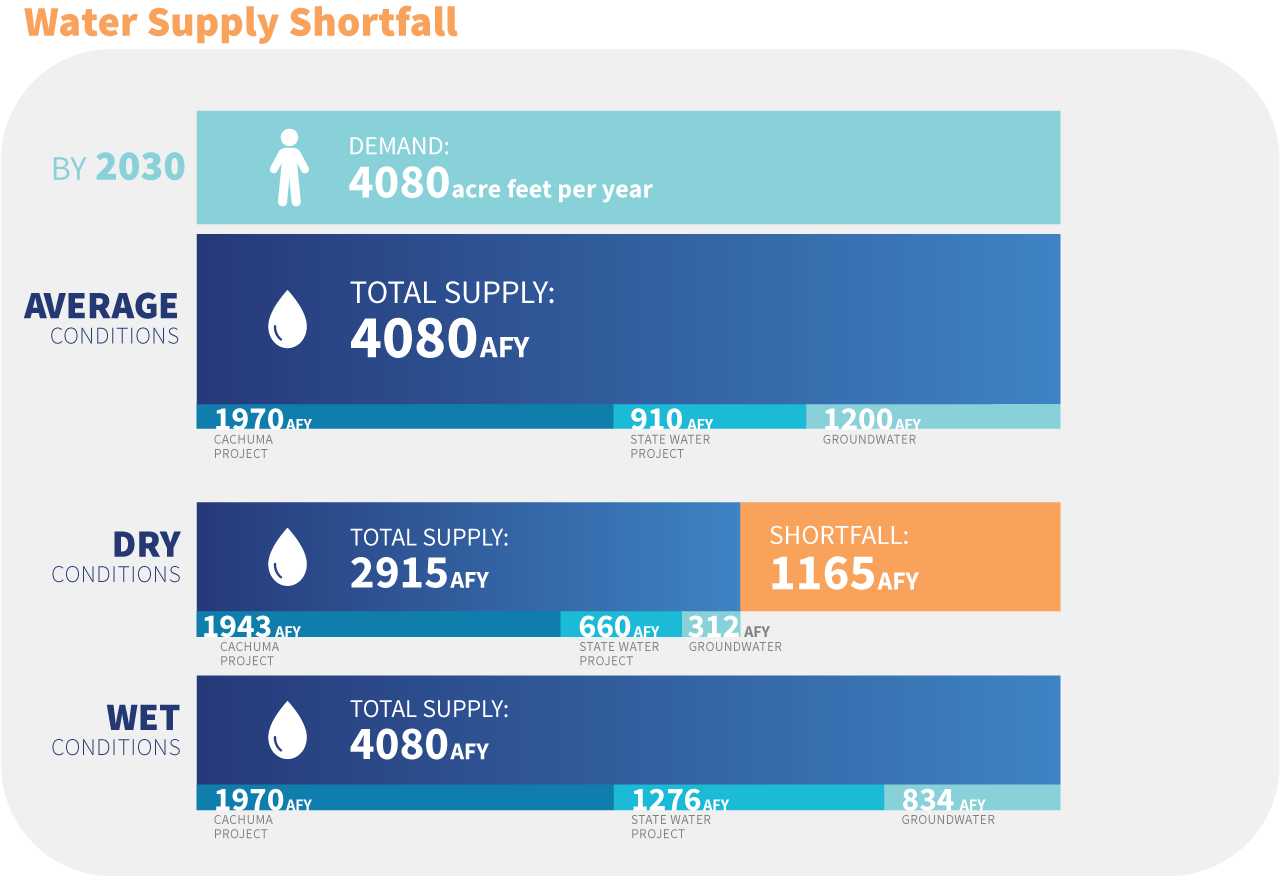
During extended drought conditions, Carpinteria faces a shortfall of 1165 acre feet (AF) per year--over 29% of total customer water needs. AF is a measurement of water volume1 foot of water over an acre.
CAPP is an “indirect potable reuse” project that involves taking water that has already been cleaned at the Carpinteria Sanitary District (CSD) Wastewater Treatment Plant, purifying it in a newly-constructed Advanced Water Purification Facility, then delivering it through a pipeline to injection wells for storage in the groundwater basin. The project could ultimately provide up to 1000 acre feet (AF) per year for storage in the Carpinteria Valley Groundwater Basin – enough to meet over a quarter of CVWD’s water needs. Currently, this valuable resource is treated at CSD’s existing plant and discharged to the Pacific Ocean.
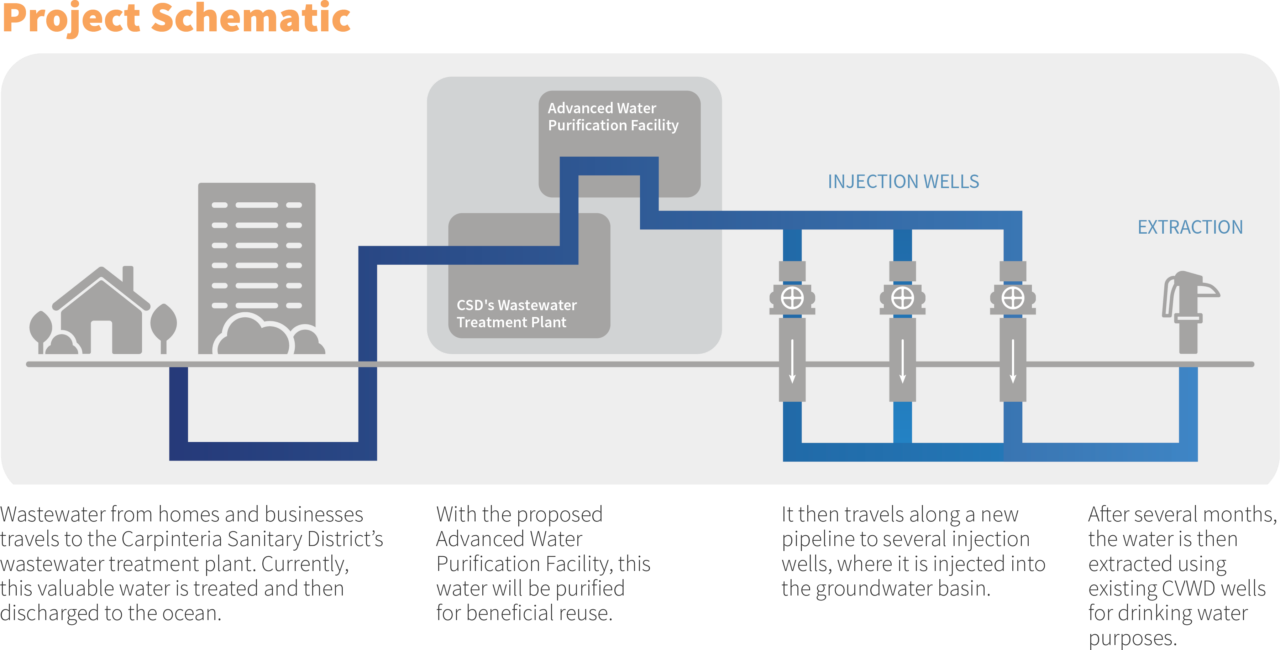
What is Groundwater Replenishment?
Groundwater is water from precipitation that naturally percolates and is stored underground in the soil or in cracks and crevices between rocks. Once recycled water has been purified to meet or exceed drinking water standards, it will be injected into the ground through wells where it will blend with existing groundwater and to replenish or “refill” the groundwater basin. The blended water will sit for several months before it is pumped out and cleaned one last time before being added to the distribution system. The groundwater in the Carpinteria Valley has been depleted in the recent and recurring droughts, straining one of Carpinteria’s major water supplies. By replenishing the groundwater basin with water that can be used for drinking, residents and businesses in Carpinteria will have a reliable, renewable supply of water for generations to come.
What is Advanced Water Purification?
Advanced Water Purification describes proven, multi-step processes that purify water which has already been cleaned at a wastewater treatment plant. The advanced purification process uses a multi-step treatment process including membrane filtration, reverse osmosis, and ultraviolet/advanced oxidation resulting in water that is pure to replenish the groundwater basin. This system of scientifically proven technology is being used throughout California and the United States.
For more information about water reuse and the different processes and uses, visit the WateReuse Association website at www.athirstyplanet.com.
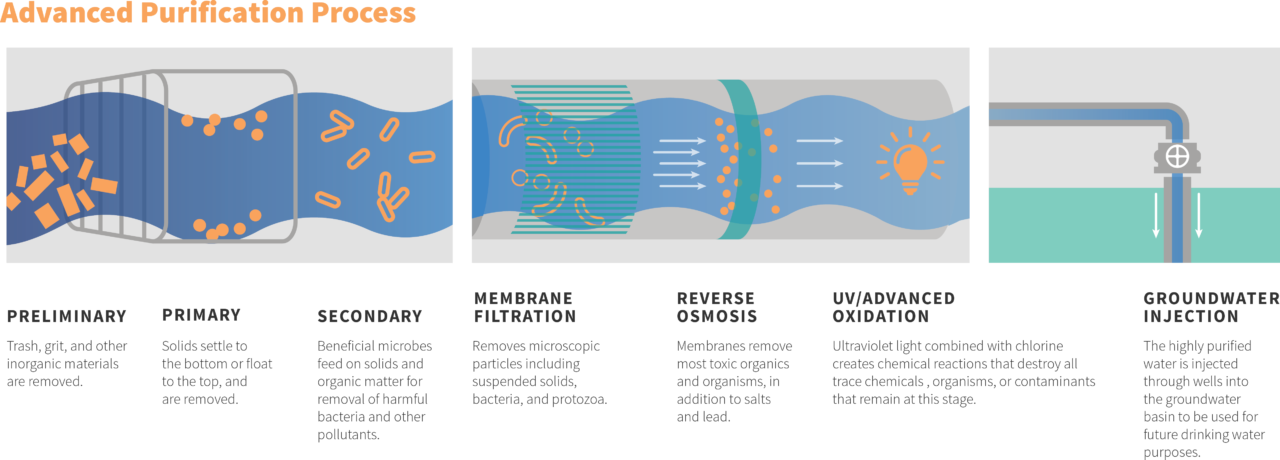
Carpinteria Valley Water District, Carpinteria Sanitary District, and the City of Carpinteria have worked closely together to find efficient and affordable solutions to ensure a sustainable water supply for Carpinteria.
The Carpinteria Advanced Purification Project is a result of collaboration between Carpinteria Valley Water District, Carpinteria Groundwater Sustainability Agency and Carpinteria Sanitary District.
Additionally, consultation between the State, County of Santa Barbara and City of Carpinteria has been extensive.
The Carpinteria Valley Water District and Carpinteria Sanitary District are now moving forward with final design and permitting of the project. This phase of work will continue through 2024. The plan is to construct facilities starting in late 2025 and have CAPP operational by the end of 2028.
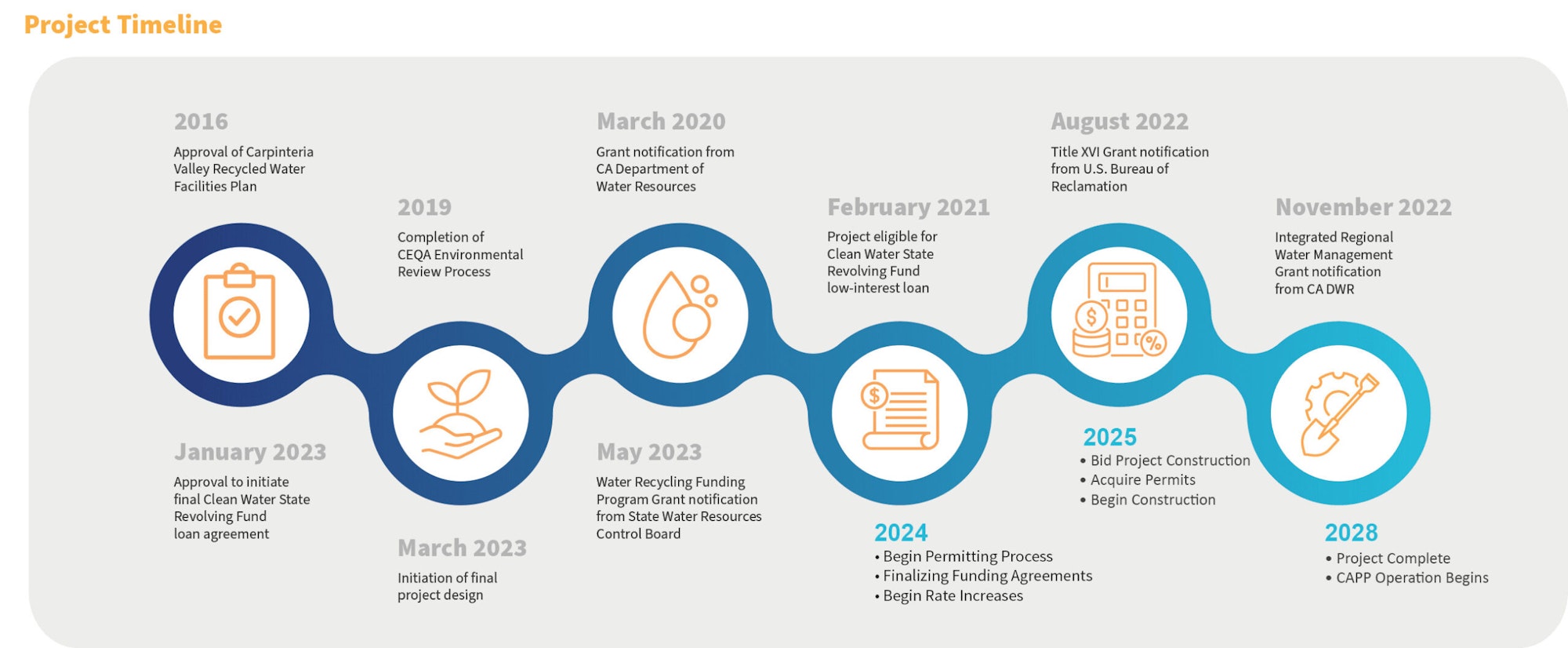
Frequently Asked Questions
Print FAQs hereThe Carpinteria Advanced Purification Project – known as CAPP – is a project to purify recycled water and replenish the groundwater basin, creating a locally-controlled drinking water supply that will augment existing supplies and serve as a dependable, drought- resistant source of water for our future.
Specifically, this project involves taking water that has already been fully treated at the Carpinteria Sanitary District (CSD) Wastewater Treatment Plant, purifying it in a newly-constructed Advanced Water Purification Facility, using a proven, multi-step treatment process, then delivering it through a pipeline to injection wells for storage in the groundwater basin. Currently, over a million gallons of valuable water from the CSD plant is treated and discharged to the Pacific Ocean each day.
Replenishing the groundwater basin with water that can be used for drinking purposes, also known as “indirect potable reuse,” will not only assist in supplementing the local water supply but is also safe, sustainable, and environmentally friendly.
Over the past few decades, the Carpinteria Valley Water District (CVWD) and our customers have seen just how unpredictable our surface water supplies are during times of continuing and historic drought, due to our State Water Project and Lake Cachuma allocations becoming extremely variable and unreliable. When faced with limited surface water, we have become highly dependent on pumping groundwater from the Carpinteria Groundwater Basin to deliver water to your tap. However, groundwater takes years to recharge and requires steady and consistent winter rain which is never guaranteed. CAPP will create a solution that provides us with a locally managed and controlled water supply every day, including during times of prolonged drought and water supply shortages.
The primary benefit of CAPP is that it provides a new, local supply of water that is independent of climate impacts and competing water needs. It also provides a high-quality source of water to replenish our groundwater basin and reduces the amount of valuable water we discharge to the ocean each day. CAPP is one of many efforts – including continued focus on conservation – to offset declining water resources and improve water supply reliability.
Currently we rely on three sources of supply to meet water demand in its service area.
Cachuma Project: The District receives 50 to 70 percent of its water from the Cachuma Project, which stores water in Lake Cachuma. The District’s annual allotment for Cachuma Project Water is 2.5 million gallons per day as well as an additional 356,000 gallons per day from an exchange with the Santa Ynez Water Conservation District, Improvement District No. 1.
State Water Project: The District has an allotment of State Water of 1.8 million gallons per day. However, SWP reliability is highly variable and has been cut back by 95 percent in dry years and on average deliveries are about 50 percent on a long-term basis.
Groundwater: Based on annual availability of other supplies, the District pumps approximately 2.0 million gallons per day of groundwater from the Basin.
The Cachuma Project and State Water Project water, which can be impacted by a number of factors including competing demands, seismic activity and drought, comprises roughly three quarters of the District’s existing supplies, but these sources were only able to meet roughly one quarter of the District’s demand during the recent extended drought.
While the Carpinteria Groundwater Basin is relatively healthy compared to many others throughout the state, our imported supplies are becoming more expensive and less reliable. The State Water Project remains an expensive source of supply that is highly variable and is subject to extreme cutbacks during drought conditions. It is crucial to invest in a local water supply that is not subject to the same vulnerabilities as the existing imported supplies.
Conservation, or water use efficiency, remains an important part of Carpinteria’s effort to reduce dependence on imported water, but it is not enough to ensure water supply reliability for the future, especially in times of drought.
Potable means drinkable, or safe to drink.
Potable reuse is the planned introduction of purified water either directly or indirectly into a water system for future drinking water purposes. Scientists and public health professionals have been working for decades to ensure safe processes that are routinely monitored and there are many potable reuse projects across California and the United States.
CAPP is an “indirect potable reuse” project that involves taking water that has already been cleaned at the Carpinteria Sanitary District (CSD) Wastewater Treatment Plant, purifying it in a newly-constructed Advanced Water Purification Facility, then delivering it through a pipeline to injection wells for storage in the groundwater basin. The project could ultimately provide up to 1.3 million gallons of water per day for storage in the Carpinteria Valley Groundwater Basin – enough to meet over a quarter of CVWD’s water needs. Currently, this valuable resource is treated at CSD’s existing plant and discharged to the Pacific Ocean.
Advanced Water Purification describes proven, multi-step processes that purify water which has already been cleaned at a wastewater treatment plant. The advanced purification process uses a multi-step treatment process including membrane filtration, reverse osmosis, and ultraviolet/advanced oxidation resulting in water that is pure to replenish the groundwater basin. This system of scientifically proven technology is being used throughout California and the United States.
For more information about water reuse and the different processes and uses, visit the WateReuse Association website at www.athirstyplanet.com.
Groundwater is water from precipitation that naturally percolates and is stored underground in the soil or in cracks and crevices between rocks. Once recycled water has been purified to meet or exceed drinking water standards, it will be injected into the ground through wells where it will blend with existing groundwater and to replenish or “refill” the groundwater basin. The blended water will sit for several months before it is pumped out and cleaned one last time before being added to the distribution system. The groundwater in the Carpinteria Valley has been depleted in the recent and recurring droughts, straining one of Carpinteria’s major water supplies. By replenishing the groundwater basin with water that can be used for drinking, residents and businesses in Carpinteria will have a reliable, renewable supply of water for generations to come.
Advanced water purification is used throughout the world and there are many projects similar to CAPP across California and the United States. Many other agencies have led the way demonstrating the success and safety of water purification and water reuse projects throughout California. Some of these local projects include: Las Virgenes-Triunfo’s Pure Water Project, Pure Water Monterey’s groundwater replenishment project, and Orange County Water District’s Groundwater Replenishment System (GWRS). Orange County’s GWRS is currently the largest advanced water purification system in the entire world, producing 130 million gallons per day of purified water. Each of these projects are regulated by California’s State Water Resources Control Board (SWRCB) just like CAPP will be. In addition, similar projects are in or near construction in Soquel, Oxnard, Ventura, Pismo Beach, Morro Bay, Calabasas, San Diego, eastern San Diego County, and Los Angeles. To see who in the State of California is currently providing or proposing to provide purified recycled water, visit: https://watereuse.org/sections/watereuse-california/potable-reuse-map-of-california/
Yes. Our singular responsibility is to ensure high quality water to our customers, and we want to assure you that the multi-step advanced water purification process is effective and safe for our community. In potable reuse projects, recycled water is purified to meet or exceed federal and state drinking water standards and is safe for human consumption. Our team of scientists and engineers working on CAPP design are highly qualified and have worked on other projects similar to ours around the state and country. In addition, there are multiple regulatory agencies that will oversee the design process and the final quality of the water produced by CAPP. Maximum contaminant levels (MCLs), secondary MCLS, and notification levels exist for a broad range of water constituents and contaminants. These standards are based on health-based research and are re-evaluated as new research is made available. We are required to meet or exceed these levels, sample CAPP water regularly, and report water quality results demonstrating that we are producing a final product that passes strict water quality standards.
There are multiple regulatory agencies that will oversee the design process and the final quality of the water produced by CAPP. These regulatory agencies have had significant experience working with the 12 existing advanced purification projects across California, and with many new similar projects currently underway and have stringent requirements in place to ensure safety and public health. The State Water Resources Control Board, Division of Drinking Water and the Central Coast Regional Water Quality Control Board review water quality reports and have final approval of the production and distribution of CAPP water.
The proposed project includes construction of an Advanced Water Purification Facility (AWPF), a pump station and 12-inch diameter pipeline to deliver the purified water to two groundwater injection wells. Four new monitoring wells would also be required to monitor the health of the groundwater basin. CVWD’s existing groundwater production wells would be used to extract the purified water back out of the groundwater basin for use in the drinking water supply.
The Carpinteria Valley Water District and Carpinteria Sanitary District are now moving forward with final design and permitting of the project. This phase of work will continue through 2024. The plan is to have CAPP operational by the end of 2026 to provide supply to meet roughly one quarter of the annual water demands and build up groundwater storage to ensure the community of Carpinteria is better prepared for the next extended drought.
The District is committed to ensuring you have up-to-date information about construction activities and
will work closely with the City and neighbors to minimize impacts during construction. Construction impacts, such as noise, dust or traffic, were analyzed as part of the Environmental Impact Report (EIR) process, and the District will work with project neighbors and businesses to address any questions or concerns as we move forward. Once construction is complete and the facility is operational, the District does not anticipate any significant impacts to the nearby neighbors and businesses. . The best way to stay up-to-date on this project is to join the email list by visiting www.cvwd.net/CAPP.
The project will be paid for through State and Federal grants, a low-interest loan, and water rate revenue. The Carpinteria Valley Water District has secured grant funding for more than 50 percent of construction costs, and the District is doing everything it can to secure additional grant funding to minimize rate impacts for customers from the project. We anticipate some rate increase for customers in order to build this project but are committed to keeping those increases as minimal as possible.
Project capital cost for the CAPP is estimated to be about $49 million. Costs to operate the system will be similar to the cost of managing our other water supplies.
Visit www.cvwd.net/CAPP for more information and to sign up for project update emails. You may also call the Carpinteria Valley Water District at (805) 684-2816, or the Carpinteria Sanitary District (805) 684-7214.
